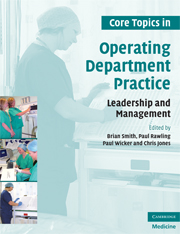Book contents
- Frontmatter
- Contents
- List of contributors
- Foreword
- Preface
- 1 Managing change in perioperative education
- 2 The role of the operating department manager within the context of the organization
- 3 Action learning: a new way of problem solving in perioperative settings
- 4 Agenda for change: what do theatre staff need to know?
- 5 The SWOT analysis: its place in strategic planning in a modern operating department
- 6 Corporate governance: setting the scene for perioperative practice
- 7 Managing different cultures: adversity and diversity in the perioperative environment
- 8 Leadership in perioperative settings: a practical guide
- 9 Management and leadership of advanced practice
- 10 Managing conflict in perioperative settings
- 11 The management and organization of emergency operating lists
- 12 Organizational culture
- 13 Development matters in the NHS; including a perioperative approach to the KSF
- 14 Equipment procurement: a purchaser's guide for theatre managers
- 15 The reflective practitioner in perioperative settings
- 16 New ways of working in perioperative practice
- 17 Damned if you do and damned if you don't: whistle blowing in perioperative practice
- 18 A manager's experience of recruitment and retention
- 19 The management of change
- Index
- References
13 - Development matters in the NHS; including a perioperative approach to the KSF
- Frontmatter
- Contents
- List of contributors
- Foreword
- Preface
- 1 Managing change in perioperative education
- 2 The role of the operating department manager within the context of the organization
- 3 Action learning: a new way of problem solving in perioperative settings
- 4 Agenda for change: what do theatre staff need to know?
- 5 The SWOT analysis: its place in strategic planning in a modern operating department
- 6 Corporate governance: setting the scene for perioperative practice
- 7 Managing different cultures: adversity and diversity in the perioperative environment
- 8 Leadership in perioperative settings: a practical guide
- 9 Management and leadership of advanced practice
- 10 Managing conflict in perioperative settings
- 11 The management and organization of emergency operating lists
- 12 Organizational culture
- 13 Development matters in the NHS; including a perioperative approach to the KSF
- 14 Equipment procurement: a purchaser's guide for theatre managers
- 15 The reflective practitioner in perioperative settings
- 16 New ways of working in perioperative practice
- 17 Damned if you do and damned if you don't: whistle blowing in perioperative practice
- 18 A manager's experience of recruitment and retention
- 19 The management of change
- Index
- References
Summary
Key Learning Points
A discussion of the relationship between national health service development and education
Current influences on and key aspects of professional development
Fundamental factors in implementation of the Knowledge and Skills Framework
A practical approach to PDP evidence collection and recording for perioperative practitioners
Development matters in the NHS
The cumulative effect of several significant Department of Health (DH) initiatives has arguably contributed to the current emphasis on performance development within the National Health Service (NHS). Consideration of the literature suggests that policy appears to be driven by two key and connected aspects of reform: modernization of services including, the efficiency and effectiveness of those services; and continuing development of health care professionals. Directives including the introduction of the National Patient Safety Agency – Building a safer NHS for Patients (DH 2001), Creating a Patient-led NHS (DH 2005a) and the development of Foundation Trusts (DH 2005c) are instrumental to the modernization agenda and strive to ensure a safe approach to care that is not only patient focused but patient led. Initiatives supporting continuing professional development, including Modernizing Medical Careers (DH 2004a), Modernizing Nursing Careers (DH 2006c), and the regulation of Health Professionals in the twenty-first century (Secretary of State 2007) could be considered the vehicles by which service developments may be achieved.
- Type
- Chapter
- Information
- Core Topics in Operating Department PracticeLeadership and Management, pp. 107 - 120Publisher: Cambridge University PressPrint publication year: 2009



